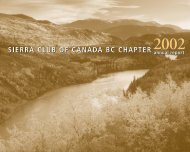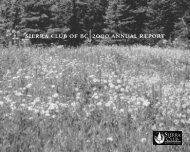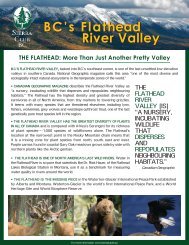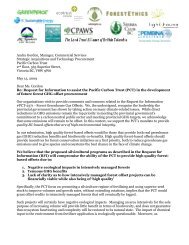Bogus Business? Bottling Bute - Sierra Club BC
Bogus Business? Bottling Bute - Sierra Club BC
Bogus Business? Bottling Bute - Sierra Club BC
Create successful ePaper yourself
Turn your PDF publications into a flip-book with our unique Google optimized e-Paper software.
WATER<br />
plant in Cranbrook which obtained<br />
water from a local well. Ice River<br />
Springs now serves its <strong>BC</strong> market<br />
from Calgary. In a smaller but similar<br />
rationalization, Snowcap Waters of<br />
Fanny Bay sold its mid-Vancouver Island<br />
customer base to Duncan-based<br />
Columbia Ice, and closed its bottling<br />
plant forever.<br />
Some bottlers obtain water from<br />
“pristine glacial” sources and from<br />
a local well or tap. Natural Glacial<br />
Waters trucks its Névé brand “super<br />
premium glacial water” 160 km from<br />
the Adam River west of Sayward to<br />
its plant at Fanny Bay on Vancouver<br />
Island. Its less special “glacial spring”<br />
brand, Canadian Icefield, is obtained<br />
from a local well with no glacier anywhere<br />
nearby. Perhaps the glacier is<br />
When we’re done, tap water<br />
will be relegated to showers<br />
and washing dishes.<br />
—Susan Wellington, president of<br />
Quaker Oats’ US beverage division.<br />
underground, suggesting that hell is<br />
freezing over. Its primary markets<br />
are Asian. Watermark Beverages of<br />
Vancouver follows the same scheme.<br />
It obtains its Ice Age and Canadian<br />
Music water from Alpine Creek in<br />
Toba Inlet, and the rest from Vancouver’s<br />
municipal supply. Its big market<br />
is California. These and many other<br />
bottlers will bottle their water with<br />
your label, or you can supply your<br />
own water.<br />
A drop in the bucket<br />
Until 2000, there were about 29<br />
licences issued in <strong>BC</strong> allowing water<br />
removal from streams, lakes, and<br />
springs for bottling purposes. From<br />
2000 to 2007 – the end of the boom<br />
years – there were another 13 issued.<br />
Issued licences total 22,637 cubic metres<br />
per day (m3/d) (22,637,000 litres).<br />
When it is multiplied out to litres<br />
or gallons, it seems like a lot of water.<br />
Compared to the volumes of water removed<br />
from <strong>BC</strong>’s lakes and streams<br />
for most other purposes, however,<br />
water for bottling is simply not on<br />
the same scale. It is even less than the<br />
36,000 m 3 /d used for snow-making at<br />
Whistler-Blackcomb, less than a tenth<br />
Continued on Page 26 <br />
Watershed Sentinel 25<br />
March-April 2011









